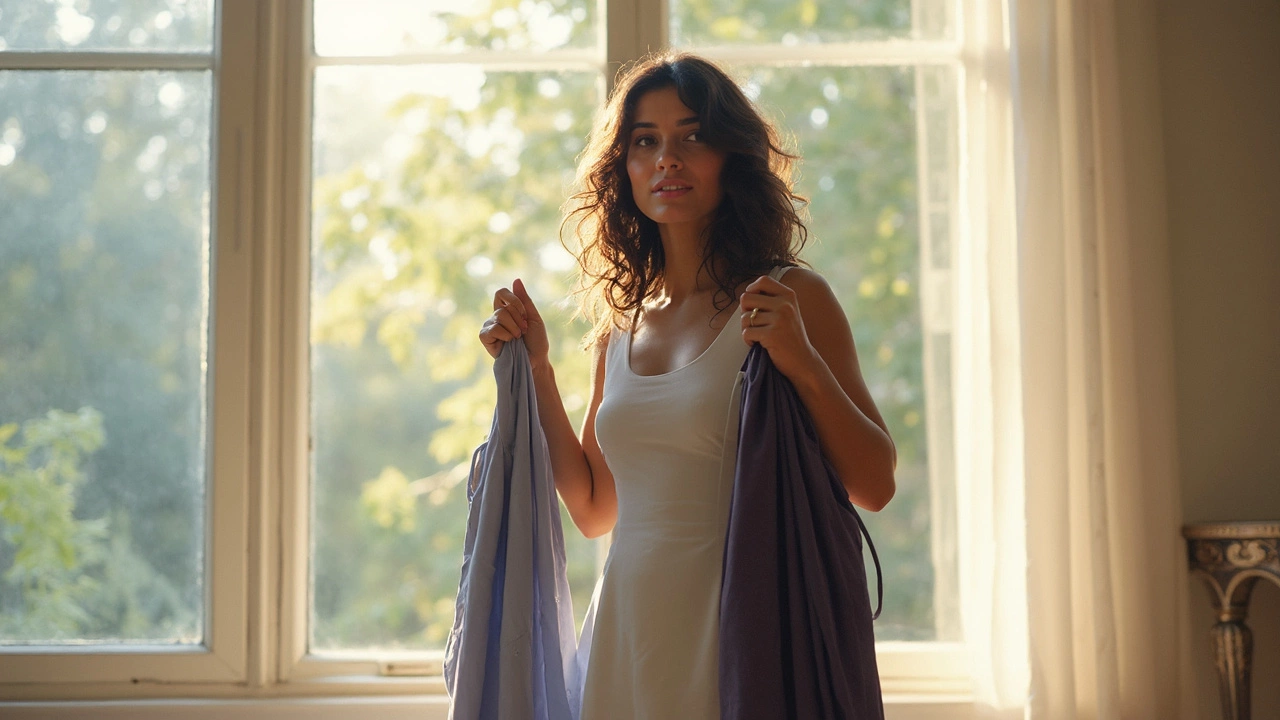Ever notice how some summer dresses turn you into a human radiator? That’s not just in your head—what you wear actually changes how hot you feel. There’s real science behind how certain colors interact with sunlight, and knowing what not to wear can save you from sticky, sweaty days.
For starters, colors like black and deep navy might look chic, but they’re basically magnets for heat. Dark shades soak up sunlight and trap warmth against your skin. You end up feeling hotter, even if the dress itself is light and breezy. So if you’re heading out in peak sun, those classic little black dresses are better left for the evening.
- The Science Behind Color and Heat
- Colors That Make You Sweat More
- Why Some Colors Look Bad in Bright Sun
- Colors Prone to Staining and Sweat Marks
- Better Alternatives for Staying Cool
- Style Tips for Summer Confidence
The Science Behind Color and Heat
There’s a reason you always hear about wearing lighter colors in the summer. It comes down to how colors behave under sunlight. Dark colors, especially black and navy, absorb more of the sun’s rays. When sunlight hits a dark-colored dress, that fabric grabs on to the energy and holds it, turning it into heat. You just end up feeling way warmer than you need to.
Lighter shades, like white or pale yellow, reflect sunlight instead of soaking it in. That means less heat actually gets trapped against your body. This isn’t just style advice—it’s basic science. The U.S. Department of Energy has said,
"On a sunny day, a black shirt absorbs almost twice as much heat as a white one, making you feel hotter and sweatier faster."
Here’s a quick look at how much light and heat different colors can absorb:
| Color | Heat Absorbed (%) |
|---|---|
| Black | 90-95% |
| Dark Blue | 80-85% |
| Grey | 60-65% |
| White | 10-15% |
So if you toss on a black dress in July, you’ll be sweating it out compared to someone in white or light pink. Sticking to lighter shades is the easiest way to keep cool—especially when you want to enjoy summer without turning into a hot mess. Remember, your choice of summer colors can make all the difference when the sun is blazing.
Colors That Make You Sweat More
You probably already know dark colors aren't your friend under the summer sun. When it comes to summer colors, sticking with the wrong shades will make you feel like you’re baking. Black, navy, dark brown, and charcoal grey all hold onto the sun’s heat, making your skin feel way warmer than it needs to be.
Here’s what happens: dark colors absorb almost all the sunlight that hits them instead of bouncing it away. Light colors reflect sunlight. That means if you’re wearing black or dark blue, you trap more heat and your body reacts by sweating more to cool itself down.
- Black is the top offender—absorbs the most light and makes you sweat the fastest.
- Navy and other dark blues don’t let much heat escape, either.
- Deep green, maroon, and dark brown act almost as badly as black in the heat.
In fact, a study completed in Japan found that black t-shirts got an average of 9 degrees Fahrenheit hotter than white ones in direct sunlight. That’s a huge difference on a sweltering day—and it totally changes how comfortable you’ll feel in a summer dress.
| Color | Heat Absorption Ranking |
|---|---|
| Black | Highest |
| Navy/Dark Blue | Very High |
| Brown/Maroon | High |
| Light Colors (White, Pastel) | Low |
If you want to keep sweat marks under control and avoid feeling like a walking sauna, avoid these darker summer colors. Lighter shades really do keep you cooler—not just style-wise, but in real science.
Why Some Colors Look Bad in Bright Sun
Ever put on what looked like a great dress in the mirror, only to step outside and suddenly hate how the color looks? It’s a common summer problem. Bright sunlight can totally change how colors appear. Some colors get so washed out under harsh light, while others start looking awkwardly loud, almost like they’re glowing in all the wrong ways.
Pale yellows, for example, might look soft and cute indoors. But out in the sunlight, they can blend right into your skin tone—making everything look dull and kind of faded. Same goes for certain beiges and pastels. Even white sometimes gets overwhelmingly bright and can make you squint just looking at yourself in photos.
Then there are neon shades. They might feel fun when you’re under store lights, but outside, they jump right off your body. Neon pink, green, and orange can almost feel like they’re giving you a glow stick effect. Unless your goal is to stand out in a crowd or go for that festival look, these shades might not work for a casual day out.
Another annoying problem is how some cool-toned colors, especially blue and purple, can look dingy in direct sunlight because of shadows and how sunlight distorts cooler hues. This means that what looked fresh and vibrant in your bedroom suddenly seems flat or even grayish by afternoon.
Check out which summer colors tend to go weird in the sun:
- Pale yellows and some beiges—risk looking washed out or making skin look uneven
- Neon pinks, greens, and oranges—unexpectedly harsh or blinding outdoors
- Certain pastels—fade out and lose their pop completely
- Some whites—look too bright, sometimes almost see-through
- Cool blues and purples—can appear dull or muddled
If you’re unsure, try taking a quick selfie in natural light before heading out. That’s the real test for which dress tips you want to follow—make sure your summer dress looks just as sharp outside as it does in your closet!

Colors Prone to Staining and Sweat Marks
Ever spend a summer day out, only to realize your dress has embarrassing sweat patches showing by noon? Some colors just make this worse. If you’re worried about sweat marks, avoid wearing super light and super dark shades during hot months. Both ends of the spectrum have their own problems when it comes to summer colors and sweat.
Let’s break it down: White and other very light shades like pale yellow, beige, and light grey might seem like the best choice for beating the heat. But they almost act like a highlighter for any damp patches. Even the smallest bit of moisture shows up fast and sticks out, especially on thin or clingy materials.
On the flip side, dark colors like black, navy, and dark green do one thing well—they mask sweat stains. But here’s the trade-off: they absorb much more heat, so you’re likely to sweat more in the first place. Even with better camouflage, you might just feel less comfortable the longer you’re outside.
| Color | Sweat Visibility | Heat Absorption |
|---|---|---|
| White/Pale Shades | High | Low |
| Light Grey | Very High | Low |
| Bold Colors (Red/Blue) | Medium | Medium |
| Black/Navys | Low | High |
Another one to skip? Pastel blue and pastel green. They show all kinds of stains: sweat, food, or even an accidental spill from an iced coffee run. No one wants to stress about keeping their dress spotless all day long.
- Go for mid-tone colors. Medium shades—like olive, medium blue, or rich coral—don’t show sweat easily and they don’t absorb as much heat as dark colors.
- Look for prints and patterns. A busy design can distract from any marks and keep your style on point.
This way, you’ll stress less about those awkward sweat marks and spend more time enjoying the sun.
Better Alternatives for Staying Cool
If you want to actually enjoy summer without sweating buckets, the answer lies in picking smarter summer colors. Light colors with high reflectivity bounce the sun’s rays away, so your outfit acts like your own shade. Whites, creams, and soft pastels like baby blue, blush pink, and mint are game-changers for keeping you cooler.
Here’s why: Think about how sunlight hits a white dress compared to a black one. White reflects almost all light, while black absorbs it. This difference is big enough that researchers at the National Renewable Energy Laboratory found white fabric can be up to 31°F (about 17°C) cooler in direct sun than black fabric. That’s not just a little less sweat—it's the difference between comfort and misery.
Off-whites and gentle earth tones also play well in the heat, making sweat less visible than pure white or heavy, saturated colors. Pastel yellow, sky blue, and mint green all do a great job at looking fresh while keeping you comfortable.
- Dress tips: Go for loose-fitting styles in light shades. The combo of flowy fabrics and pale colors gives your skin space to breathe and doesn’t lock in the sun’s heat.
- Print options: Light backgrounds with subtle patterns or small florals can disguise minor sweat marks, while still looking lively.
If you’re worried light clothes are see-through, choose fabrics with a tight weave or an extra slip underneath—still much cooler than suffering in dark colors on a blazing day. And, of course, check out labels for 100% cotton or linen—natural fibers help you stay dry and comfortable.
Here’s a quick comparison to help you spot the best color choices for summer dresses:
| Color Type | Heat Absorption | Mood/Appearance |
|---|---|---|
| White | Minimal | Fresh, classic |
| Cream/Beige | Low | Warm, subtle |
| Pastel Blue | Low | Bright, youthful |
| Light Pink | Low | Soft, playful |
| Mint Green | Low | Trendy, cool |
Swapping out heavy, dark colors for these lighter shades won’t just help with heat. You’ll actually look more awake—and nobody will spot those awkward sweat patches either.
Style Tips for Summer Confidence
If you want your summer dresses to make you look good and feel comfortable, there are a few easy style tricks that work every time. First, pay attention to how colors affect your mood and confidence. Light shades—like white, pastels, yellows, and soft greens—not only help you stay cooler, but they also reflect more sunlight, so you’re less likely to feel overheated. That’s why white is still the most popular summer color. Fashion magazine surveys consistently show white as the most purchased summer clothing shade over the past five years.
Patterned dresses help, too. Prints and small patterns, especially in lighter backgrounds, are awesome at hiding sweat marks, accidental stains, and even wrinkles. They can make you look put together with zero effort. Avoid big, blocky designs in heavy colors, though, since they tend to feel (and look) hotter.
Let’s talk fabrics. Even a great color won’t help if your dress isn’t made to breathe. Go for options like cotton, linen, or seersucker. These natural fibers let air flow and wick sweat, keeping you fresh. According to the International Journal of Clothing Science and Technology, linen clothes can keep you up to 6 degrees cooler than polyester blends.
The fit actually matters more than you’d think. Loose, A-line, and flowy cuts don’t cling to your skin, giving you that breezy summer vibe. Tight dresses, especially in dark or synthetic colors, are basically summer torture devices.
- Stick to cool tones and lighter, pastel shades.
- Pick small prints or patterns for a polished, sweat-proof look.
- Invest in natural, breathable fabrics like cotton and linen.
- Choose relaxed fits to boost airflow.
- Carry a stain wipe or wear a slip if you’re worried about sweat marks.
When you avoid the classic summer dress mistakes—like dark colors and unbreathable materials—you end up looking sharp, feeling cool, and walking with confidence. It’s way easier to enjoy summer vibes when you aren’t worrying about sweat stains or overheating in your outfit. So don’t let the heat mess with your style—be smart, pick the right colors, and rock your summer with confidence.

